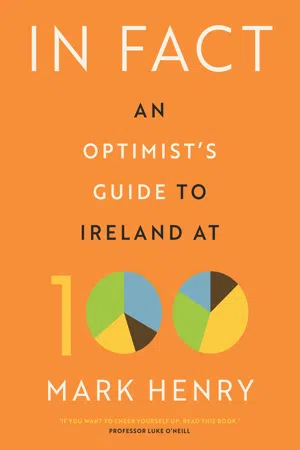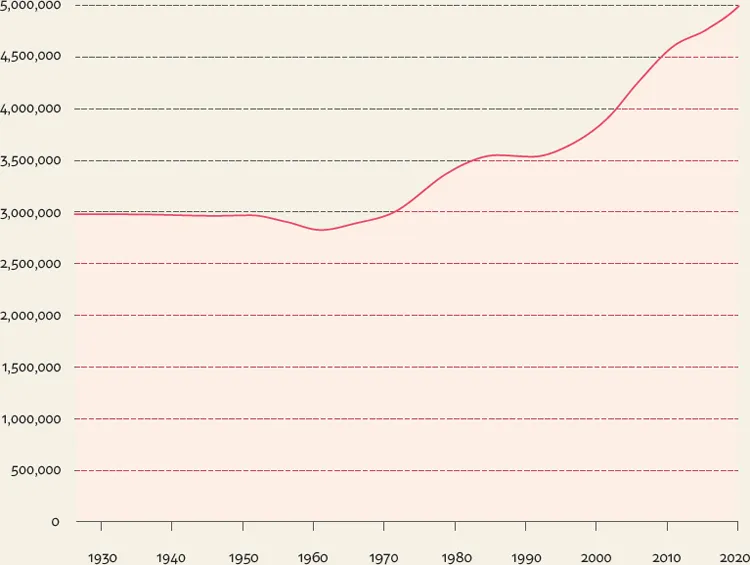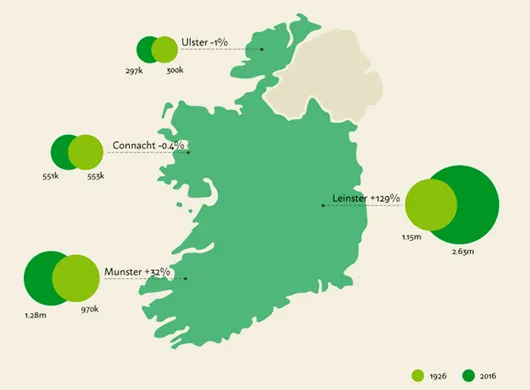![]()
Living Longer
WHO BELIEVES IN MIRACLES? WELL, SCIENTIFIC AND MEDICAL MIRACLES AT ANY RATE? WE HAVE EXPERIENCED ONE IN IRELAND IN THE COURSE OF A SINGLE GENERATION: THE GREAT BIG MIRACLE OF HUMAN PROGRESS. WE ARE WINNING THE BATTLE AGAINST AN EARLY DEATH.
WOMEN ARE SURVIVING childbirth, children are living through their early years and adults are avoiding fatal accidents like never before. We therefore live much longer than our ancestors. That, alongside the occasional baby boom and the elimination of emigration, has contributed to record population growth.
| The Population of Independent Ireland Has Never Been Higher |
There was no growth at all in the population of independent Ireland for its first fifty years. From 1921 until 1971 there were no more than 3 million people living here. An historic low was reached in 1961 when we recorded only 2.8 million residents. Then an explosion happened
The population of Ireland, 1926–2020
SOURCE: CENTRAL STATISTICS OFFICE
Over the following four decades, up to the turn of the millennium, we added one million additional souls. In just the past two decades, we have added a further million. I expect that more than five million of us will be here to celebrate the 100th anniversary of Ireland’s independence in December 2022 – a record high.
The last time the population of the 26 counties that constitute the Republic of Ireland exceeded that number was 170 years ago in the immediate aftermath of the potato famine that was responsible for the death and departure of so many people. Before that occurred, the figure peaked at 6.5 million people.
So what happened in the past 50 years to reverse so many decades of stagnation and decline?
Population change is easy to calculate. It is the number of births minus the number of deaths (the so-called ‘natural increase’), plus the number of people immigrating into the country minus the number that emigrated (labelled ‘net migration’).
Independent Ireland has always had a positive natural increase. Yet for fifty years our population did not grow. The sole reason was emigration.
The outflow predated the birth of the State but continued unabated until the start of the 1970s. We had a net inflow of migrants for the first time then as we joined the European Union (at the time called the European Economic Community or EEC) and the country benefited from increasing international trade. They were mainly Irish people returning from working overseas to avail of new job opportunities at home. Despite a return to emigration during the recession years of the 1980s and early noughties, we have had a nearly unbroken run of net immigration since the start of the 90s with an increasing number of migrants from other EU countries helping our population reach new heights.
The natural increase in the population exhibited some notable ebbs and flows too. There were approximately 60,000 children born every year in Ireland from the 1920s right up to the 1960s. A baby boom occurred in the 1970s and early 80s with an additional 10,000 children born per annum. The figure dropped again, before growing in the noughties and the 2010s as those who were born in the previous boom became the parents of a new generation, thirty years later.
With a downward trend in the number of deaths, the natural increase in the population has therefore grown in recent decades. In the 1970s the annual increase was more than twice that of the 1920s and 30s. In the late noughties the growth was more than three times higher.
Over the past 20 years the contribution of greater natural increases and increased immigration to our robust population growth has been roughly equal. Half our recent growth has been due to declining deaths and more babies, and half has been due to Irish people returning from overseas and new migrants arriving for the first time.
Population by province, 1926–2016
SOURCE: CENTRAL STATISTICS OFFICE
That growth has not happened equally all over Ireland, however. Like every other country on the planet, the trend has been unequivocally towards urbanisation. It has resulted in the population of Leinster growing unabated throughout the past century to become the dominant province. It has more than doubled in size to 2.6 million, making Dublin the fastest growing of all European capitals since the turn of the century.1
Munster has also grown. Its population decreased by more than 100,000 until the mid-1960s, since which it has grown by over a third to reach a record 1.28 million. The populations of Connacht and Ulster, however, have not changed at all. Despite Ireland gaining an additional 1.8 million people over the past 90 years, the population of the two provinces nowadays is precisely the same as it was back in the 1920s.
The changing nature of employment is a critical factor. When the State was founded, most of the available jobs were in agriculture in the countryside. One hundred years later, most of our jobs are in services in urban areas. We have consequently changed from being predominantly a rural country to being an urban one.
| We Have More Than Halved Our Death Rate |
The number of people who died in that year per 1,000 of population
SOURCE: CENTRAL STATISTICS OFFICE
Throughout the first three decades of Irish independence, your chances of dying remained essentially unchanged. Fourteen or fifteen out of every 1,000 people died each year. Men, women and children passed for every reason imaginable: illness, accidents, old age. Little or no progress was made in tackling these causes up until the early 1950s.
Then the Great Big Miracle of Human Progress began to take effect. The death rate began to fall. On average, we have managed to save the life of one additional person out of every thousand in each subsequent decade.
Many things contributed to this. The spread of infectious diseases was reduced through improved living conditions and less overcrowding, alongside improved water and sanitation provision. Access to medical services was transformed, particularly for those who would not have had the income to pay for them in the past. Advances in medical treatment have been extraordinary, such as the development of antibiotics, chemotherapy and cardiac interventions. Huge public health initiatives were put in place, for example for immunisation, infection control and antenatal screening. Nutrition has been transformed – our diets today would be unrecognisable to our ancestors. And education about good health practices is widespread, so our collective understanding of what is good for us has never been greater.
Today, only six people in every thousand fail to see the year through. The chances of you dying this year are less than half what they were 100 years ago. Now that’s what I call progress.
We will explore advances on many of these fronts in this chapter and the next. Let’s start with one of the greatest contributors to the reduction in deaths – our success in ensuring that our children do not die young.
| The Likelihood of a Child Surviving Their First Year Has Improved 25-Fold |
Deaths of infants under one year of age per 1,000 births, 1922–2019
SOURCE: CENTRAL STATISTICS OFFICE
Infants under one year of age had to endure a battle for survival in the early years of the Irish State. Right up to the 1940s, seven in every 100 children – that is, one in 14 – died before their first birthday.2 Astonishingly, the death rate for ‘illegitimate’ children born outside of marriage was one in three.3 It is hard to imagine the scale of the trauma for parents and for the siblings left behind.
Those born in the early years of the State’s independence faced significant challenges, most particularly poverty. Larger families lived in much smaller spaces and ate far less well than today. Disease passed easily from person to person in confined surroundings and amongst those too nutritionally weak to fight them off. And many of the advances of preventative medicine had yet to be made.
Starting in the mid-1940s an unrelenting, continuous improvement in infant mortality began. Children’s allowances were introduced for the first time in 1944 with the express aim of reducing poverty in large families.4 The cost represented an increase of over one-quarter in government expenditure and took place even though World War II was ongoing.
The first standalone Department of Health was created in 1947 with a dedicated minister. The Health Act introduced that same year paved the way for a new approach to tackling tuberculosis and other infectious diseases by offering free diagnosis and treatment and allowances to sufferers. It aimed to secure cleanliness in the handling and sale of food and the fixing of proper nutritional standards.
When Noël Browne became Minister for Health in 1948 he sought to implement the Act’s provision for free, state-funded healthcare for all mothers and their children aged under 16 without a means test. This so-called ‘Mother and Child Scheme’ ran into deep opposition from doctors in private practice and from the hierarchy of the Catholic Church. Church leaders claimed that the scheme would interfere with parental rights and feared that the provision of non-religious medical advice to mothers would lead to birth control. Under pressure, the government backed away from the scheme and forced Browne’s resignation as minister. As a result, Ireland adopted a two-tiered health system of public and private provision rather than the national health service which Britain implemented at this time.
Nevertheless, government expenditure on health doubled in the following five years. Free ante-natal care for women and free hospital services to those on lower and middle incomes were introduced in the 1950s.
Child mortality halved in just ten years from the mid-1940s to the mid-1950s, and it halved again by the early 1970s, when it dropped below 2 per cent for the first time. Continued improvements in incomes and housing raised living standards and made a significant contribution. More notably, there was huge progress in disease prevention. Vaccination was introduced in the 1950s and 60s and successfully eliminated several debilitating and killer diseases.
If you were born in 1970 you had a 98 per cent chance of surviving your first year. For those born just ten years later the survival rate reached 99 per cent. B...








